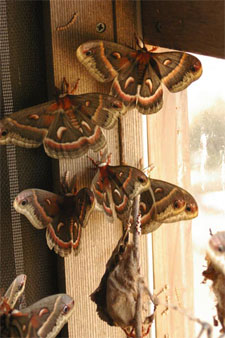Raising Native Caterpillars

These cecropria moths are among nearly 100 eclosed (hatched) in the Lady Bird Johnson Wildflower Center’s insectary about one week ago.
Photos by Philip Hawkins.
Life is a miracle. Nature is amazing! Raising a caterpillar is a fascinating and easy way to observe nature close up. Pollinators such as moths and butterflies are critical to the reproduction and continuation of many native plants.
Here are some tips on successfully rearing a butterfly or moth larva (caterpillar) to maturity:
1. Find eggs or larvae in your garden or local natural area. Mail-order insects are not recommended; they are usually bred from individuals outside of our region and are likely not adapted to our climate or native vegetation.
2. Observe the plants on which they are feeding or are found. If they are eating a plant, continue feeding that species to the caterpillar. If the eggs are on a non-plant item, it can be tricky to determine what to feed the larvae. You may opt to raise only those for which you know the food preference.
3. Collect eggs or caterpillars, taking care not to squish them, and place them in a sealable container. A glass jar with fabric covering the mouth and secured with a rubber band is an easy way to go.
4. Put fresh plant sprigs into the container. To prevent immediate drying out and wilting, wrap a bit of heavily moistened paper towel around the cut end of the plant, or try stem tubes used for cut flowers found at florist shops. (An open container of water can be a deadly drowning hazard for caterpillars.)
5. Check on your new pets daily to clean out frass (droppings) and refresh the food. Allowing too much moisture or frass to collect will make disease more likely. Ventilation is important, not so much to prevent the insect from suffocating as it is to discourage pathogens.
6. As the caterpillars grow, they may need to be transferred to larger or separate vessels. Don’t overcrowd the container with too many individuals.
7. Be sure to provide suitable places for pupating insects to attach themselves as they form their chrysalises. A small stick is ideal. Often larvae will become lethargic and stop eating just before pupating. Or they may get very active, wandering around in search of a good place.
8. Once you have a pupa (chrysalis), check on it frequently to see if it has eclosed (hatched). Depending on the species, it may take from 1-1/2 weeks to many months (as is the case for cecropia moths). Most chrysalises do not visibly change as they get ready to squeeze out a butterfly or moth, but a monarch will turn dark a day or two before this event, giving a useful clue to its schedule.
Note: Newly eclosed butterflies or moths will need a few hours to inflate and stiffen their wings with fluid. They are weak and vulnerable during this time and won’t immediately fly away, providing a good opportunity to pull out the camera.
9. A fully formed adult should be released outdoors to forage on flower nectar and other nutrients and lead a healthy, albeit in most cases short, life.
10. If you have a female and she has mated, you can follow her through the garden to gather any freshly laid eggs and begin the adventure all over again!
Rearing butterflies and moths is a perfect activity to do with children, but adults don’t need kids as an excuse. It’s fun for anyone to do!
For more information about Texas native plants, visit the Wildflower Center’s website at www.wildflower.org.
About the author: Andrea DeLong-Amaya is the director of horticulture at the Lady Bird Johnson Wildflower Center in Austin.
Correction: Plant photos shown in Wild About Texas last month were taken by Joe Marcus, a member of the Wildflower Center staff.
